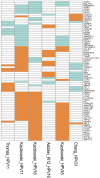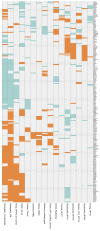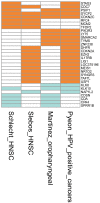A Decade of Global mRNA and miRNA Profiling of HPV-Positive Cell Lines and Clinical Specimens
- PMID: 23341857
- PMCID: PMC3547333
- DOI: 10.2174/1874357901206010216
A Decade of Global mRNA and miRNA Profiling of HPV-Positive Cell Lines and Clinical Specimens
Abstract
For more than a decade, global gene expression profiling has been extensively used to elucidate the biology of human papillomaviruses (HPV) and their role in cervical- and head-and-neck cancers. Since 2008, the expression profiling of miRNAs has been reported in multiple HPV studies. Two major strategies have been employed in the gene and miRNA profiling studies: In the first approach, HPV positive tumors were compared to normal tissues or to HPV negative tumors. The second strategy relied on analysis of cell cultures transfected with single HPV oncogenes or with HPV genomes compared to untransfected cells considered as models for the development of premalignant and malignant transformations.In this review, we summarize what we have learned from a decade of global expression profiling studies. We performed comprehensive analysis of the overlap of the lists of differentially expressed genes and microRNAs, in both tissue samples and cell culture based studies. The review focuses mainly on HPV16, however reports from other HPV species are used as references. We discuss the low degree of consensus among different studies and the limitation of differential expression analysis as well as the fragmented miRNA-mRNA target correlation evidence. Furthermore, we propose an approach for future research to include more comprehensive miRNA-mRNA target correlation analysis and to apply systems biology/gene networks methodology.
Keywords: Cervical cancer; HPV; head-and-neck cancer; messenger RNA profiling; miRNA..
Figures





Similar articles
-
Combined Transcriptome and Proteome Analysis of Immortalized Human Keratinocytes Expressing Human Papillomavirus 16 (HPV16) Oncogenes Reveals Novel Key Factors and Networks in HPV-Induced Carcinogenesis.mSphere. 2019 Mar 27;4(2):e00129-19. doi: 10.1128/mSphere.00129-19. mSphere. 2019. PMID: 30918060 Free PMC article.
-
miR-3156-3p is downregulated in HPV-positive cervical cancer and performs as a tumor-suppressive miRNA.Virol J. 2017 Feb 4;14(1):20. doi: 10.1186/s12985-017-0695-7. Virol J. 2017. PMID: 28160779 Free PMC article.
-
Modulation of microRNA-mRNA Target Pairs by Human Papillomavirus 16 Oncoproteins.mBio. 2017 Jan 3;8(1):e02170-16. doi: 10.1128/mBio.02170-16. mBio. 2017. PMID: 28049151 Free PMC article.
-
Expression of SESN1, UHRF1BP1, and miR-377-3p as prognostic markers in mutated TP53 squamous cell carcinoma of the head and neck.Cancer Biol Ther. 2017 Oct 3;18(10):775-782. doi: 10.1080/15384047.2017.1373212. Epub 2017 Sep 8. Cancer Biol Ther. 2017. PMID: 28886272 Free PMC article. Review.
-
Human papillomavirus and head and neck cancer: epidemiology and molecular biology.Head Neck. 1998 May;20(3):250-65. doi: 10.1002/(sici)1097-0347(199805)20:3<250::aid-hed11>3.0.co;2-o. Head Neck. 1998. PMID: 9570632 Review.
Cited by
-
An oral keratinocyte life cycle model identifies novel host genome regulation by human papillomavirus 16 relevant to HPV positive head and neck cancer.Oncotarget. 2017 Jun 1;8(47):81892-81909. doi: 10.18632/oncotarget.18328. eCollection 2017 Oct 10. Oncotarget. 2017. PMID: 29137231 Free PMC article.
-
Reverse-phase protein array profiling of oropharyngeal cancer and significance of PIK3CA mutations in HPV-associated head and neck cancer.Clin Cancer Res. 2014 May 1;20(9):2300-11. doi: 10.1158/1078-0432.CCR-13-2585. Epub 2014 Mar 5. Clin Cancer Res. 2014. PMID: 24599934 Free PMC article.
-
Genome-wide miRNA profiling reinforces the importance of miR-9 in human papillomavirus associated oral and oropharyngeal head and neck cancer.Sci Rep. 2019 Feb 19;9(1):2306. doi: 10.1038/s41598-019-38797-z. Sci Rep. 2019. PMID: 30783190 Free PMC article.
-
Clinical implications of (epi)genetic changes in HPV-induced cervical precancerous lesions.Nat Rev Cancer. 2014 Jun;14(6):395-405. doi: 10.1038/nrc3728. Nat Rev Cancer. 2014. PMID: 24854082 Review.
-
The Prognostic Role of Baseline Eosinophils in HPV-Related Cancers: a Multi-institutional Analysis of Anal SCC and OPC Patients Treated with Radical CT-RT.J Gastrointest Cancer. 2023 Jun;54(2):662-671. doi: 10.1007/s12029-022-00850-y. Epub 2022 Aug 1. J Gastrointest Cancer. 2023. PMID: 35915202 Free PMC article.
References
-
- Hausen zur H. Human papillomaviruses and their possible role in squamous cell carcinomas. Curr Top Microbiol Immunol. 1977;78:1–30. - PubMed
-
- Bosch FX, Burchell AN, Schiffman M, et al. Epidemiology and natural history of human papillomavirus infections and type-specific implications in cervical neoplasia. Vaccine. 2008;26(Suppl 10 ):K1–16. - PubMed
-
- Du J, Nasman A, Carlson JW, Ramqvist T, Dalianis T. Prevalence of human papillomavirus (HPV) types in cervical cancer 2003- 2008 in Stockholm, Sweden, before public HPV vaccination. Acta Oncol. 2011;50(8 ):1215–9. - PubMed
-
- Lajer CB, von BC. The role of human papillomavirus in head and neck cancer. APMIS. 2010; 118(6-7 ):510–9. - PubMed
LinkOut - more resources
Full Text Sources
